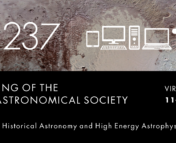
In this series of posts, we sit down with a few of the plenary speakers of the 240th AAS meeting to learn more about them and their research. You can see a full schedule of their talks here, and read our other interviews here!
Exoplanet discovery may seem like an everyday occurrence now, but after the Nobel Prize-winning discovery of 51 Pegasi b in 1995, astronomers were shocked. The first confirmed exoplanet orbiting a Sun-like star was nothing like anyone had ever imagined. Half the mass of Jupiter, and whizzing around its star in just over 4 days, 51 Peg b, and the rest of its Hot Jupiter cousins that followed, seriously challenged our ideas on how planets and planetary systems could form. Professor Rebekah Dawson has spent her career trying to answer this and other questions about how planets form and move around in their solar systems. For today’s bite, Astrobites sat down with her ahead of her Helen B. Warner Prize lecture at AAS 240 to hear a bit more about her work and career path.
The Diversity of Planetary Systems
We observe all sorts of planets in the galaxy, from our own Solar System, to Hot Jupiters, to pea-pod systems of closely packed terrestrial planets. What do these observations tell us about how these planetary systems form and evolve? Prof. Dawson and her group have spent much of their time working on these problems, especially with respect to how planetary orbits change over time. In order to explain the presence of Hot Jupiters, Dawson’s group investigates several mechanisms. Giant planets may form close to their stars, being born as Hot Jupiters. They may form on highly elliptical orbits which gradually become circular from tidal forces from their host stars, dropping the planet down into a hot, close orbit. Or, they may form on circular orbits further out in the gaseous disk around the star, and by interacting with the gas gradually lowers its orbit to become a Hot Jupiter.
However, it’s not just giant planets that need explanation. Super-Earths and mini-Neptunes (planets larger than Earth but smaller than Neptune) are the most common planets in the galaxy, are often found on short orbits, and don’t exist in our own solar system. Whether in single or multiple planet systems, these planets tried to become gas giants, but were only able to accrete a little bit of gas from their disks. Dawson’s research aims to predict a wide range of observable properties of these planets depending on where they formed and how they evolved.
Finally, the last major topic for Dawson’s group is the protoplanetary disks themselves. These disks can be observed in varying stages of planet formation, and the remnants of disks after planets have already formed may still have evidence of the evolution of those planets.
Unexpected Observations
Dawson says that theorists like herself have an interesting time catching up to observational breakthroughs in astronomy. “Whenever we get access to new parameter space, it seems like so far we’ve always found planets there, no matter whether we expect to or not.” New observations always bring a significant amount of information on their targets, like the unexpected discovery of super-Earths and mini-Neptunes. From transit surveys, we observe these planet’s sizes, and radial velocities reveal their masses, allowing for a rough characterization of large numbers of planets. Dawson predicts that the biggest breakthrough in the immediate future will be observations from the nearly fully commissioned JWST, especially deep studies of planetary atmospheres and their specific components. These detailed measurements are sorely needed for better understanding planetary formation and its observational signatures.
Good Problems Fight Back
One of the most helpful things Dawson heard during her graduate career came while she was working on a particularly tough research problem after coming into the office on a weekend. She and a senior faculty member were the only people in the building, and she mentioned to him that she was stuck on something in her research, to which he replied, “Good problems have a way of fighting back.” Being stuck on something doesn’t mean that you’re failing at what you do, or that you should get discouraged about your research and quit. Astrophysics isn’t easy, some of the most worthwhile problems in our field are challenging, and who knows, maybe you’ll be the one to finally crack the mystery of Hot Jupiter formation!
Professor Rebekah Dawson will be giving the Helen B. Warner Prize Lecture at the 240th meeting of the American Astronomical Society, Wed. June 15, at 11:40 AM PDT. Professor Dawson will also be chairing the Multi-Faceted Views of Planet Formation meeting-in-a-meeting on Wednesday, June 15 and Thursday, June 16. Locations can be found in the AAS Meeting Schedule.
Astrobite edited by Briley Lewis
Featured Image Credit: American Astronomical Society


